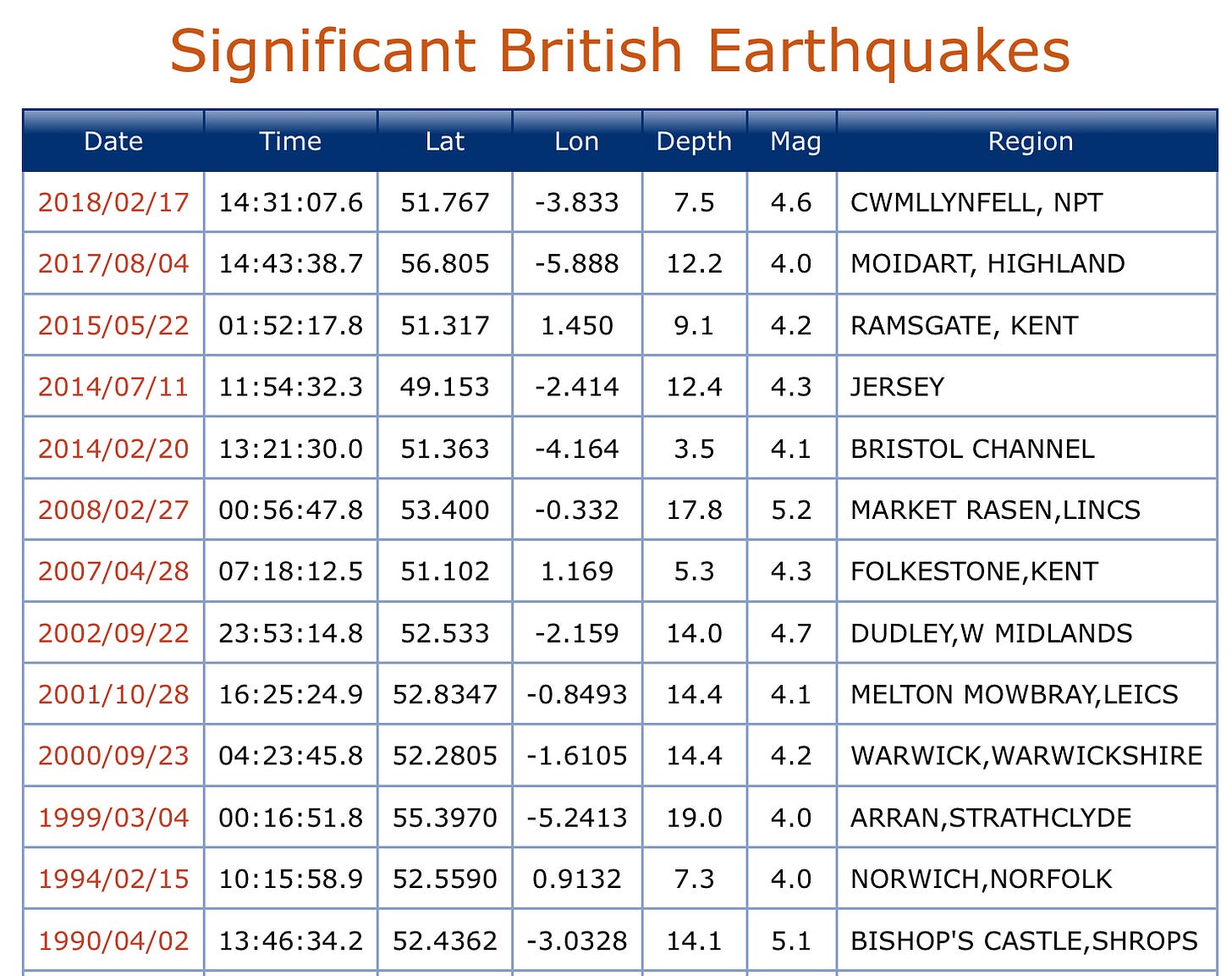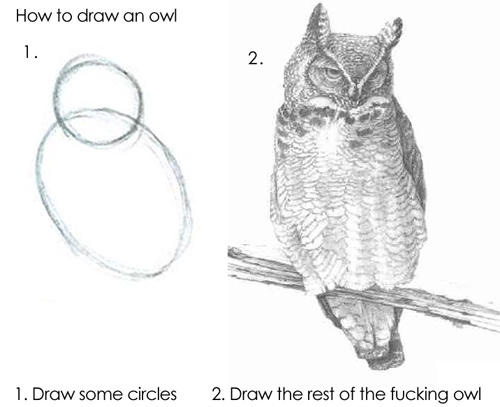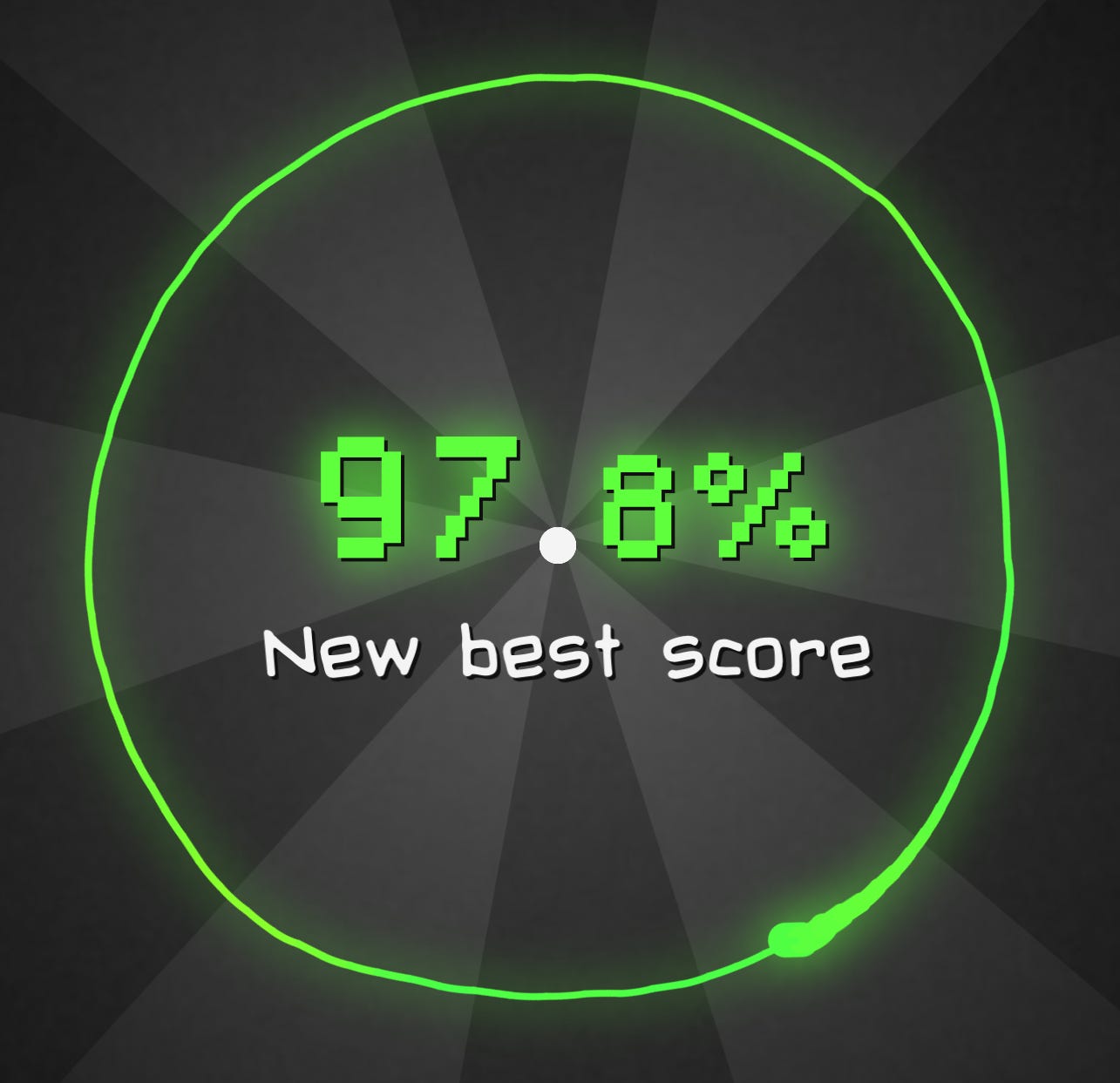Thing 1 – Earthquakes
I grew up, and live, in a country where earthquakes are a rarity. When we get one strong enough to slightly displace a chimney it usually gets a mention at the end of the news, in the ‘novelty’ slot. There are, after all, far greater risks to public safety.
So colour me mildly surprised to learn that Britain has experienced 53 earthquakes defined as ‘significant’. But then uncolour me again, because, looking at this chart, the definition of ‘significant’ seems to be that it must register 4.0 or more, which in the grand scheme of things is defined as ‘light to moderate’.
Since the beginning of this year 39 earthquakes have been recorded in Britain, not that most people would be aware of it. Just eight of them were strong enough to be felt by people (rather than merely registering on seismographs) and three of those were on the same day in the same place.
The only quake I have knowingly experienced happened during a concert in San Francisco, and even then I only heard about it afterwards (I was conducting Shostakovich at the time, which might have had something to do with it).
So it’s difficult to imagine living somewhere where they’re a regular occurrence – just part of life. And it’s easy to be blasé about it – earthquakes in Britain have caused a mere ten recorded fatalities, the most recent in 1940. But of course for many people in many parts of the world the consequences of earthquakes are devastating, the most recent example being the earthquake in Japan on New Year’s Day. The effects of these events are long-lasting, even when they are only in the headlines comparatively briefly. Just after the first anniversary of the Turkey-Syria quakes, thousands of people remain displaced and lives disrupted and devastated (you can read more and donate here).
All of which is leading to a couple of things.
First, for those in need, a brief explanation of earthquake magnitude.
Second, this deceptively pretty map of global seismic activity in 2020.
And, for good measure, a similar one of California of earthquakes over 100 years.
And finally, for those of you who might be wondering where the magnitude scale begins and ends, and what the effects are of the various numbers on it, here’s XKCD to explain.
Thing 2 – Cage
‘Organ changes chord’ shouldn’t be news. But when it’s the first time in two years, and the change is part of a piece designed to last another six and a bit centuries, you can bet it’s going to get some attention.
I mentioned John Cage’s As Slow As Possible (or, to give it its full name, ORGAN2/ASLSP (As Slow as Possible)) all the way back in Volume 7. The scheduled chord change (the sixteenth since the performance started in Halberstadt in Germany in 2001) duly took place last week with the addition of a pipe to the instrument to enable the new chord. The next change will be in August 2026, and the performance will finish in 2640. There’s an explanation of the reasoning behind the apparently arbitrary end date on the project’s website.
You might be tempted to think that As Slow As Possible, in the same way as the composer’s 4’33”, is a cheap musical gimmick. But Cage was a thinker and an experimenter. 4’33” is often presented as a comedy item, the embarrassment of both audience and performers manifesting as nervous giggles at the very idea of it. But Cage’s intention was to make us think about the nature of silence. He said of the premiere:
“They missed the point. There's no such thing as silence. What they thought was silence, because they didn't know how to listen, was full of accidental sounds. You could hear the wind stirring outside during the first movement. During the second, raindrops began pattering the roof, and during the third the people themselves made all kinds of interesting sounds as they talked or walked out.”
(There’s more about silence in Volume 9)
And so it is with As Slow As Possible. Even mention of it triggers thoughts about how we perceive time, the scale of the music, the impossibility of a single human experiencing the whole piece. You imagine standing in that room, listening to that chord – out of context, possibly little more than an annoying sound that you want to stop. But then you imagine a being for whom 640 years is equivalent to a human day, and you realise that it’s all a matter of scale and how you perceive time, and from there you turn to thoughts of the incomprehensible vastness of geological time and for that matter space, and before you know it you’re thinking about the weirdness of space-time and wondering exactly where we fit into the whole glorious shambles and asking yourself what is, in fact, when you come down to it, the meaning of all existence and suddenly you need a drink.
Or perhaps it’s just an annoying sound that you want to stop. I wouldn’t want to overthink it.
Anyway, if I do find myself in the area at any point, I fully intend to drop in and complain loudly that they’re taking it too fast.
The marvellous Isabel Rogers wrote a marvellous poem about As Slow As Possible, which I reproduce here with her permission. You should hasten to buy her books immediately.
Thing 3 – Moon
Talking of perspective, please enjoy this three-minute lesson in it from Alex Gorosh. Highly recommended.
Thing 4 – Art
Because I’m slow, I’ve only just found out about the existence of this terrific resource, a huge collection of non-copyright art, free to browse and download. You need a membership to download hi-res images, but nevertheless.
A brief browse (yes of course I searched ‘birds’ first) threw up this: ‘how to draw an owl’.
Which is rather more helpful than the meme version.
Thing 5 – Circles
And while we’re on drawing circles, some while ago I shared this exasperating activity.
I share it again a) to annoy you and b) to boast.
But I also do it to draw your attention to this important research.
Thing 6 – Models
These gorgeous postcard models are a perfect example of the kind of thing I find beguiling and interesting and make me think ‘ooh I must get one of those and make it’, as well as also being an example of the kind of thing that would have me swearing and throwing it across the room in a matter of minutes.
Perhaps best not. But don’t let me stop you.














Another great read. In the style of a character from the Fast Show, I think we all should adopt the excuse/reason we didn’t experience or do something as ‘ I was conducting Shostakovich at the time’
Interesting on the earthquakes. Between 2007 and 2013, I experienced one in Kettering, during the night. I was on the fifth floor which maybe made it more apparent. It was close to the main railway, so at first I assumed it was a particularly heavy goods train, (they also shook the building somewhat) but the silence was uncanny and ruled out a train. According to the list, that could only have been the Market Rasen quake, which was quite some distance to have such an impact.
Love ‘how to draw an owl’, that’s 👌
Thank you